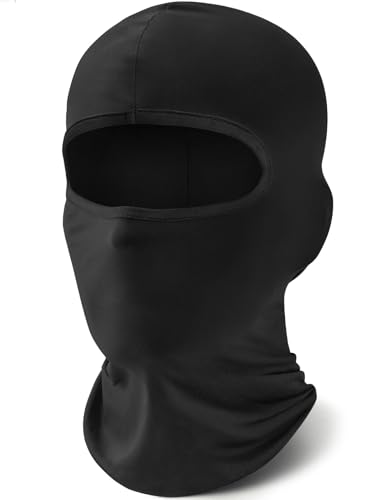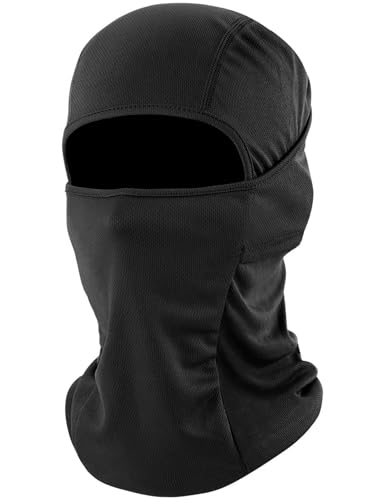Select Your Ski Mask Size
Ski Mask Size Details:
Small (20 – 21.5 inches / 51 – 54 cm)
Recommended for: Kids / Youth
Best for: Small balaclavas or neck gaiters designed for younger users or individuals with smaller heads.
Medium (21.5 – 23 inches / 55 – 58 cm)
Recommended for: Teens and adults
Best for: Standard size ski masks, balaclavas, or full-face masks for most users.
Large (23 – 24.5 inches / 59 – 62 cm)
Recommended for: Adults with larger head sizes
Best for: Full-face ski masks, larger balaclavas, or masks that require more coverage.
Extra Large (24.5+ inches / 63 cm+)
Recommended for: Individuals with larger-than-average head sizes
Best for: Larger ski masks or full-face masks for more comfort and proper fit.
Ski Mask Size Guide: Find the Perfect Fit for Your Winter Adventures
Winter sports, especially skiing and snowboarding, require the right gear for comfort and protection. While a well-fitted jacket, gloves, and boots are essential for warmth and performance, there's one item that’s often overlooked but equally crucial the ski mask. Whether you call it a balaclava, face mask, or neck gaiter, the right ski mask keeps your face warm, protected from the harsh wind, and safe from frostbite in extreme cold conditions.
Choosing the right ski mask isn’t just about picking one off the shelf. It’s important to understand how sizing works for different mask types to ensure that you’re not sacrificing comfort or functionality. A poorly fitting ski mask can lead to discomfort, wind exposure, or a fogged-up goggle situation. That’s why getting the right size is key to ensuring a seamless experience on the slopes.
We’ll break down everything you need to know about choosing the right ski mask size. From the different types of masks available to understanding sizing and how to measure for the perfect fit, this guide will help you make an informed choice. Plus, we’ve included a handy size chart to assist you in selecting the best fit for your needs.
Types of Ski Masks
First, let’s take a closer look at the different types of ski masks. Each offers unique benefits based on the conditions and the level of protection you need. Understanding the type of mask you're looking for will help you determine the best size for your needs.
1. Balaclava (Full Face Mask)
A balaclava is a full-coverage ski mask that covers the entire head, neck, and face. It has openings for the eyes, mouth, and nose, which provides maximum protection from cold, wind, and snow. Balaclavas are commonly worn by skiers, snowboarders, and mountaineers because they offer a high level of insulation and versatility.
- Best for: Extreme cold conditions, those looking for full-face coverage, and layering under helmets.
- Materials: Often made from fleece, merino wool, or synthetic materials for warmth.
- Fit: A balaclava should fit snugly against your skin to prevent cold air from entering through gaps.
2. Neck Gaiter (Neck Warmer)
A neck gaiter is a tubular piece of fabric that covers the neck, and sometimes the lower face. It’s lightweight and provides less coverage than a balaclava, making it suitable for milder winter conditions or for skiers who prefer minimal face coverage.
- Best for: Moderate cold or windy conditions, and those who want adjustable coverage for the lower face.
- Materials: Commonly made of fleece, merino wool, or stretchy synthetic materials.
- Fit: Neck gaiters are more flexible in terms of fit and can be adjusted depending on how much face coverage you want.
3. Face Mask
A ski face mask typically covers just the nose and mouth area and is usually worn with goggles. These masks are often made from breathable fabrics to prevent moisture buildup and ensure comfort during physical activity.
- Best for: Lower face protection, and for those who don’t require full head coverage.
- Materials: Often made from stretchy synthetic fabrics, neoprene, or polyester for moisture-wicking and insulation.
- Fit: It should fit snugly over the nose and mouth, but still allow for proper ventilation to prevent fogging of goggles.
4. Full-Face Ski Mask
A full-face ski mask covers the entire face, including the eyes, nose, mouth, and neck. Full-face masks are designed for extreme cold or for skiers who prefer more comprehensive facial protection. Some models are also designed with ventilation holes or adjustable parts to accommodate various weather conditions.
- Best for: Extreme cold conditions, and skiers who want maximum coverage.
- Materials: Neoprene, fleece-lined fabric, or insulated synthetics are popular for these masks.
- Fit: Full-face masks require a snug fit to ensure proper insulation and prevent air from entering around the edges.
Why Size Matters in Ski Masks
Choosing the right size ski mask is more important than simply picking the most visually appealing design. If your ski mask doesn’t fit well, it could lead to issues such as discomfort, inadequate warmth, or even safety hazards (like fogged-up goggles).
Key Reasons Why Size Matters:
- Comfort: A well-fitted ski mask will keep you warm without being too tight or too loose. Tight masks can cause headaches, while loose masks can shift around, letting cold air in.
- Breathability: A snug but comfortable fit will allow for proper airflow to prevent moisture buildup inside the mask. A mask that’s too tight may restrict airflow, leading to fogging of goggles, while a loose mask may not prevent cold air from entering.
- Performance: The right size ensures that your mask stays in place while you’re moving. Whether you’re skiing downhill, hiking, or engaging in snow activities, a well-fitting ski mask will stay in place and not interfere with your gear.
How to Measure for a Ski Mask
To choose the right ski mask size, it’s important to measure your head and face properly. Here are the steps you need to follow to ensure an accurate measurement:
1. Measure Your Head Circumference
- Use a flexible tape measure to measure the circumference of your head.
- Wrap the tape around the widest part of your forehead, just above your ears, and around the back of your head.
- Make sure the tape is snug, but not too tight. Record the measurement in inches or centimeters.
2. Measure Your Neck Circumference (For Neck Gaiters)
- If you’re purchasing a neck gaiter, measure the circumference of your neck at its widest point.
- For accurate results, measure just below your Adam’s apple, ensuring the tape is snug but not tight.
3. Check for Specific Fit Features
- Some ski masks, especially balaclavas or full-face masks, may have adjustable straps or velcro closures for a customized fit.
- If you’re unsure between two sizes, it’s often better to choose the slightly larger size for added comfort and flexibility.
Ski Mask Size Chart
To help you choose the right size ski mask based on your head circumference, here’s a detailed size chart:
| Size | Head Circumference | Neck Circumference | Recommended For | Ski Mask Type |
|---|---|---|---|---|
| Small | 20 - 21.5 inches (51 - 54 cm) | 13 - 14 inches (33 - 35 cm) | Kids / Youth | Youth-sized balaclavas, neck gaiters |
| Medium | 21.5 - 23 inches (55 - 58 cm) | 14 - 16 inches (36 - 41 cm) | Teen / Adult | Standard size for adults, balaclavas, neck gaiters |
| Large | 23 - 24.5 inches (59 - 62 cm) | 16 - 18 inches (41 - 46 cm) | Adult (larger heads) | Larger balaclavas, full-face masks |
| Extra Large | 24.5+ inches (63 cm+) | 18+ inches (46 cm+) | Adults with larger head sizes | Full-face ski masks, oversized balaclavas |
Additional Considerations for Ski Mask Fit
- Layering: If you plan to layer your ski mask under a helmet, ensure that it’s thin enough to fit comfortably without feeling tight. Some masks are specifically designed to be worn under helmets, providing warmth without bulk.
- Ventilation: If you’re skiing in warmer conditions or engaging in intense physical activity, look for a mask with ventilation or breathability features. This will help reduce moisture buildup inside the mask and prevent your goggles from fogging.
- Compatibility with Goggles: Ensure that your ski mask fits comfortably with your goggles. Some masks come with cutouts or designs that prevent interference with the goggles’ fit, while others may require specific adjustments to ensure a smooth fit.
Conclusion
Choosing the right ski mask size is essential for ensuring warmth, comfort, and safety while enjoying your winter sports adventures. Whether you’re facing extreme cold or a moderate winter day, selecting the right mask type and size will help you stay protected from the elements.
By measuring your head and neck circumference accurately and referring to the provided size chart, you’ll be able to select the perfect ski mask for your needs. Don’t forget to consider the mask’s material, breathability, and compatibility with your other winter gear. With the right ski mask in hand, you’ll be ready to tackle the slopes with confidence and warmth.
Stay safe, stay warm, and enjoy your winter activities with the perfect ski mask!






